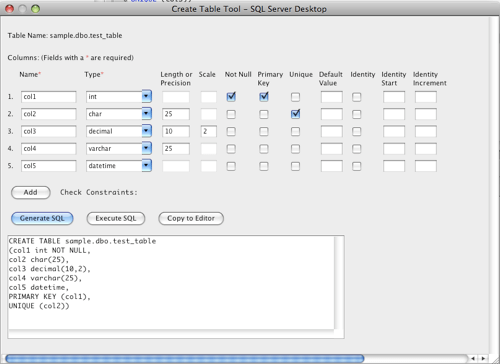Auto Generate Primary Key Sqlite
Posted : admin On 12.12.2020- Auto Generate Primary Key Sqlite File
- Auto Generate Primary Key Sqlite Free
- Sqlite Autoincrement Without Primary Key
- Pengertian Primary Key
SQLite autoincrement FAQ: How do I get the autoincrement value from my last SQLite INSERT command? You can get the integer value of the primary key field from the last insert into an autoincrement field using a SQLite function named lastinsertrowid, as shown in the example below. AUTO INCREMENT Field. Auto-increment allows a unique number to be generated automatically when a new record is inserted into a table. Often this is the primary key field that we would like to be created automatically every time a new record is inserted. Dec 19, 2014 SQLite – Auto-Increment / Auto Generate GUID David Kittell December 19, 2014 Recently was asked if it’s possible to create an auto-incrementing GUID in SQLite. I am trying to create a table with an auto-incrementing primary key in Sqlite3. I am not sure if this is really possible, but I am hoping to only have to designate the other fields. For example: CREATE TABLE people (id integer primary key auto increment, firstname varchar(20), lastname varchar(20)).
- SQLite Tutorial
- Advanced SQLite
- SQLite Interfaces
- SQLite Useful Resources
- Selected Reading
SQLite AUTOINCREMENT is a keyword used for auto incrementing a value of a field in the table. We can auto increment a field value by using AUTOINCREMENT keyword when creating a table with specific column name to auto increment.
Go get it ti download. The keyword AUTOINCREMENT can be used with INTEGER field only.
Syntax
The basic usage of AUTOINCREMENT keyword is as follows −
Example
Consider COMPANY table to be created as follows −
Now, insert the following records into table COMPANY −
This will insert 7 tuples into the table COMPANY and COMPANY will have the following records −

For a relational database like PostgreSQL, it could widely be considered a sin among developers not to include a primary key in every table. It is therefore crucial that you do your utmost to add that all-important primary key column to every table, and thankfully Postgres provides two methods for accomplishing this task.
Auto Generate Primary Key Sqlite File
Using the Serial Data Type
By far the simplest and most common technique for adding a primary key in Postgres is by using the SERIAL or BIGSERIAL data types when CREATING a new table. As indicated in the official documentation, SERIAL is not a true data type, but is simply shorthand notation that tells Postgres to create a auto incremented, unique identifier for the specified column.
Below we’ll create our simple books table with an appropriate SERIAL data type for the primary key.
By simply setting our id column as SERIAL with PRIMARY KEY attached, Postgres will handle all the complicated behind-the-scenes work and automatically increment our id column with a unique, primary key value for every INSERT.
Using a Custom Sequence
Auto Generate Primary Key Sqlite Free
In some rare cases, the standard incremental nature built into the SERIAL and BIGSERIAL data types may not suit your needs. In these cases, you can perform the same auto incremented primary key functionality for your column by creating a custom SEQUENCE, similar to the method used in older version of Oracle.
Sqlite Autoincrement Without Primary Key
Perhaps we’re particularly fond of even numbers but also have a strong distaste for anything smaller than 100, so we only want our primary key to be incremented by two starting at 100 for every insert. This can be accomplished with a custom SEQUENCE like so:
Pengertian Primary Key
Now when we INSERT a new record into our books table, we need to evaluate the the next value of our sequence with nextval('books_sequence') and use that as our id.
SEQUENCES can be spiced up even more if desired, with options like minvalue and maxvalue to of course indicate extreme values, and even CYCLE, which allows the sequence to “loop around” once it reaches the maxvalue, returning back to the start value and beginning the climb all over again. Far more information can be found in the official documentation.